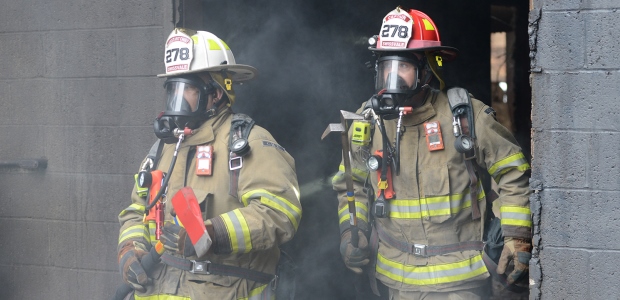
Where There's Smoke . . .
Even if we can't stop the production of deadly gases during a fire, we can take precautions to protect ourselves.
- By Mike Platek
- May 01, 2016
Being a firefighter was all I thought about when I was a kid; little did I know about the dangers associated with the fire and rescue profession. Many people in the fire service today probably feel the same way. The training and awareness that you acquire as you grow into your career as a firefighter give you a better understanding of the dangers, but there are still lingering hazards we might forget.
Smoke, for example—not unseen but hiding in places you can't see. When firefighters encounter a heavy fire and smoke situation, we wear a self-contained breathing apparatus (SCBA). We know the air is unbreathable. But it's after the heavy fire is knocked down when the unseen hazards will remain, keeping firefighters in harm’s way.
Why is Smoke So Dangerous?
Smoke contains many toxic gases. The most common are carbon monoxide (CO) and hydrogen cyanide (HCN), which are silent killers. These two compounds are now known as the "Toxic Twins" for their ability to attack the body in very poisonous ways.
These gas dangers have always been around, but their intensity has increased. Years ago, the materials that furniture and bedding were constructed from were natural materials such as wood, cotton, wool, etc. As technology has improved our daily lives, it has also supplied us with new building materials. We now have plastics and other petroleum-derived materials that produce these toxic gases.
Carbon monoxide is a simple asphyxiant, meaning it binds with the hemoglobin, the protein of the red blood cells, so it no longer can carry oxygen throughout the body. It suffocates you from the inside of your body. The most common symptoms of CO poisoning are headaches, dizziness, weakness, upset stomach, vomiting, chest pain, and confusion. CO symptoms are often described as flu-like. The other side of CO is the half-life that it has in the body. CO can be absorbed 200-300 times faster than oxygen, but only half of the absorbed CO leaves the body in five hours in normal oxygen levels, making the CO more dangerous when multiple exposures happen in a short period of time.
Hydrogen cyanide affects the central nervous system (CNS) and the respiratory system. After inhalation exposure, symptoms begin within seconds to minutes; death may occur within minutes. The time of onset of symptoms depends on the concentration and duration of exposure. Early symptoms of cyanide poisoning include lightheadedness, rapid breathing, nausea, vomiting, a feeling of neck constriction and suffocation, confusion, restlessness, and anxiety. Rapid breathing is soon followed by respiratory depression/respiratory arrest. The CNS is the most sensitive target organ of cyanide poisoning. Cardiovascular effects require higher cyanide doses than those necessary for CNS effects. In serious poisonings, the skin is cold, clammy, and diaphoretic. Blue discoloration of the skin may be a late finding and can be seen in the fingernails as a result of oxygen deprivation.
Protection During a Fire
There is a solution to these gas exposure problems. Even if we can't stop the production of deadly gases during a fire, we can take precautions to protect ourselves. Firefighters wear SCBAs in heavy fire and smoke conditions, but they are uncomfortable to work in and eventually run out of air. When an SCBA is removed, it's necessary to use gas detection equipment. Multi-gas instruments can now detect the amounts of CO and HCN in the air along with oxygen and combustible gases. You have a fighting chance against the toxic twins if you use the right instrument.
Protection After a Fire
Overhauls (salvage and cleanup) after a fire seem to be when most firefighters are exposed to CO and HCN. The fire is knocked down, you're looking for hot spots or extension, and you’re running out of air. You decide to take off your SCBA mask, but first it's time to check the air to make sure you are not exposing yourself and your crew to these deadly gases.
CO and HCN are colorless gases and are present in the light-colored smoke left after a fire. Visual identification is not a reliable way to determine the presence of toxic gases. It doesn't take that much time or effort to use a gas detection instrument to identify invisible hazards. The gas detection instruments available today are easy to use and operate and offer advanced safety features.
Using the Latest Gas Detection Equipment in the Fire Service
The newest gas detectors also offer additional features that improve safety for firefighters. Man-down and panic alarms can alert nearby responders when someone is injured or knocked unconscious. Customizable text messages can provide safety reminders at start-up; for example, "Remember your low air alarm" would remind crew members to exit an area before their SCBAs' air level gets too low. Configuration of the instruments also allows for more application coverage thanks to sensor flexibility. Now responding to the combustible gas leak or home CO detector call can be performed with a single instrument.
When I was a kid, I wanted to be a firefighter. Now, as I am an adult, my dream came true, but I want to do it safely and for a long time. Although the dangers posed by smoke and toxic gases have increased over the years, gas detection devices are keeping pace with new features to protect firefighters and first responders. With the help of the latest equipment, I won't let the toxic twins or any other gas hazard get in my way.
References
1. Centers for Disease Control and Prevention, http://www.cdc.gov/
2. NIOSH Pocket guide to Chemical Hazards
3. Fire Smoke Coalition, http://www.firesmoke.org/
This article originally appeared in the May 2016 issue of Occupational Health & Safety.